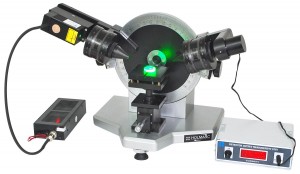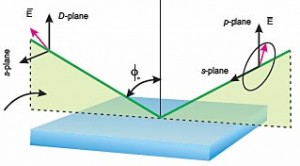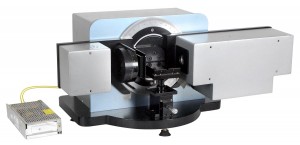Variable Angle Ellipsometer
- Variable Angle Laser Ellipsometer Model No: HO-ED-P15
- Variable Angle Spectroscopic Ellipsometer Model No: HO-SE-01
Variable Angle Laser Ellipsometer Model No: HO-ED-P15
 Ellipsometry is a very sensitive optical technique which provides unequaled capabilities for thin film metrology. Ellipsometry exploits phase information and polarization state of light and so can achieve angstrom level resolution. The main advantages of ellipsometry are its non-destructive character, high sensitivity and wide measurement range. The optical parameters like thickness and refractive indices of a thin film can be determined precisely by this technique.
Ellipsometry is a very sensitive optical technique which provides unequaled capabilities for thin film metrology. Ellipsometry exploits phase information and polarization state of light and so can achieve angstrom level resolution. The main advantages of ellipsometry are its non-destructive character, high sensitivity and wide measurement range. The optical parameters like thickness and refractive indices of a thin film can be determined precisely by this technique.
In the ellipsometer model no: HO-ED-P-06, an elliptically polarized light is made incident on the test substrate and the reflected light which is linearly polarized is analyzed for polarization changes.
The instrument consists of two concentrically rotating arms around a precisely graduated disc fixed to a heavy base. A laser source is held on one arm and the detector assembly on the other arm. The graduated disc has 1 scale and 0.1 resolution achieved through a vernier. Power supplies for laser source and detector are placed separately. Polarizer, analyzer and quarter waveplate are held in precision rotary stages in the optical path with precise graduations having 0-360 range and 0.1 resolution. Glan-Thompson Prisms are used for both polarizer and analyzer. Sample is placed on a precision micrometer driven vertical stage with height adjustment range of 10 mm and resolution 0.01 mm. Incident angle for laser source can be adjusted between 30 and 90 . For null method, detector can be replaced with a miniature screen for visual determination of null point, if required.
 As shown in the Fig., randomly polarized laser light (532nm) passes through a polarizer which changes the polarization of light from random polarization to linear polarization. The linearly polarized light then passes through a quarter-wave plate (set the fast axis at 45 degree) which changes the polarization state from linear to elliptical. After reflection from the sample thin film, the elliptically polarized light becomes linearly polarized and an analyzer measures the degree of polarization.
As shown in the Fig., randomly polarized laser light (532nm) passes through a polarizer which changes the polarization of light from random polarization to linear polarization. The linearly polarized light then passes through a quarter-wave plate (set the fast axis at 45 degree) which changes the polarization state from linear to elliptical. After reflection from the sample thin film, the elliptically polarized light becomes linearly polarized and an analyzer measures the degree of polarization.
Specifications
Measurement Range : 1 nm ~ 300 nm
Incident Angle : 30° ~ 90°, Error ≤ 0.1°
Rotation Range
Polarizer : 0° ~ 360°
Quarter-Wave : 0° ~ 360°
Resolution : 0.1 degree
Laser
Type: DPSS
Wavelength: 532nm
Output Power : 5mW
Laser Arm
Rotation range : 70 degrees (from horizontal plane)
Main scale division : 1 degree
Resolution : 0.1 degree
Detector
Type : Si Photodiode with 5.8 x 5.8mm active area
Detector Arm
Rotation Range : 70 degrees (from horizontal plane)
Main scale division : 1 degree
Resolution : 0.1 degree
Sample holder
Height adjustment range : 10mm
Drive resolution : 10 microns
tilting range : +/- 2 degree
Variable Angle Spectroscopic Ellipsometer Model No: HO-SE-01
 Spectroscopic ellipsometer is widely used for thin film and measurements. Holmarc’s spectroscopic ellipsometer incorporates Rotating Analyzer Ellipsometry technology to characterize thin film samples. It uses a high speed CCD array detection to collect the entire spectrum. It measures films from nanometer thickness up to tens of microns and the optical properties from transparent to absorbing materials. It accurately measures optical constants like refractive index, film thickness and extinction coefficient.
Spectroscopic ellipsometer is widely used for thin film and measurements. Holmarc’s spectroscopic ellipsometer incorporates Rotating Analyzer Ellipsometry technology to characterize thin film samples. It uses a high speed CCD array detection to collect the entire spectrum. It measures films from nanometer thickness up to tens of microns and the optical properties from transparent to absorbing materials. It accurately measures optical constants like refractive index, film thickness and extinction coefficient.
Our standard system comes with Quartz-Halogen lamp for visible through IR range. Our spectroscopic ellipsometer software allows the user to measure and analyze multilayer thin films and complex thin film structures. An autocollimator, Z stage and tilt platforms are provided for sample alignment. XY motorized stage and motorized rotation stages are provided as unoptional feature for mapping thin film uniformity.
Features
► Non-destructive and non-contact technique
► Analysis of single and multilayer samples
► Accurate measurements of ultra-thin films
► Software for measurement, modeling and
automatic operations.
► All range of (Ψ, Δ) can be measured.
► Uniform measurement sensitivity for (Ψ, Δ)
Where Ψ and Δ are the amplitude ratio and phase shift of the p and s components respectively. Since ellipsometry is measuring the ratio of two values, it is very accurate and reproducible.
Principle of Ellipsometry
Ellipsometry is a highly sensitive technique for thin film analysis. The principle relies on the changes of the polarization state of light when reflecting from a surface. To characterize the polarization state, corresponding to the direction of the electric filed of the electromagnetic wave; two directions are chosen as reference, p-direction (parallel) and s-direction (perpendicular). The reflected light has phase changes that are different for p-direction and s-direction. Ellipsometry measure this state of polarization;
p = rp / rs = tan Ψe iΔ
Specifications
Spectral Range : 450 – 1000nm
Detector : CCD
Resolution : 2nm
Light Source : Halogen Lamp
Goniometer : 40 – 90 degree
(Resolution: 0.1 degree, Automated operation)
Thickness Measurement Range : 0.1nm – 10micron
Resolution of film thickness : 0.01nm
Resolution of measured R.I. : 0.001
Sample alignment : Semi-automated (optical detection) with
manual 10mm height adjustment and tilt
Sample stage features : X -Y translation over 150 x 150mm (optional)
Measurable film parameters : Refractive index, extinction coefficient,
absorption coefficient and film thickness
Software Features
Acquisition and analysis of psi, delta and reflectance at different wavelengths and angles
User extendable materials library
Data can be saved as an Excel or text file
Advanced mathematical fitting algorithm
Extraction of thickness and optical constants
Parameterized models
Multi layer thickness measurement

